

I got a silent text (sms) yesterday that got caught by SnoopSnitch. : privacy. HushSMS for Android- A Silent SMS Tool. I Became a Citizen of Bitnation, a Blockchain-Powered Virtual Nation. Now What? Virtual.

Decentralized. Voluntary. Borderless. This is Bitnation, a blockchain-powered government service platform like nothing else. Except, surprisingly, Antarctica. Top 10 Invented Languages. Inventing a language from scratch might seem like an odd way to spend your time, but there are good reasons to do it.

People create languages for scientific, cultural and artistic purposes: to test theories about how the brain works, to help people communicate, to ‘improve’ existing languages, or because they just need a new language for a book they’re writing. Here are some of the best examples of invented languages: 10. Solresol Developed by Francois Sudre in the first half of the nineteenth century, Solresol is an example of an international auxiliary language: a planned, deliberately simplified language created in order to make worldwide communication easier. This arrangement meant that words could be written in musical notation, and that the language could be communicated by singing. 9. Influenza Attacks: Video Shows How A Virus Infiltrates Our Body. Avoiding influenza is everyone’s top priority come flu season.

Today we have the flu vaccination as the preferred (by most people) method for prevention, but you may be interested to know how a person sneezing near you can result in a fever, runny nose, cough, and sore throat. An animated video uploaded by NPR shows exactly how a virus invades our body and exposes our cells to the flu. Surprisingly, it’s much like opening a locked door with the right key. “When you get the flu, viruses turn your cells into tiny factories that help spread the disease,” the video description reads. “In this animation, NPR's Robert Krulwich and medical animator David Bolinsky explain how a flu virus can trick a single cell into making a million more viruses.” According to the video, it only takes one virus particle to infiltrate our body before millions are replicated unwittingly by the nucleus of our cells.
The Myth Of Autonomous Vehicles’ New Craze: Ethical Algorithms. Brett RoseCrunch Network Contributor Brett Rose is a co-founder and chief strategy officer at Leash Yourself, as well as a first-year student at NYU School of Law.
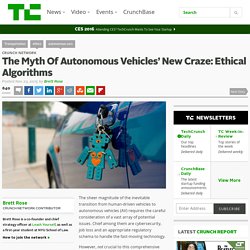
How to join the network The sheer magnitude of the inevitable transition from human-driven vehicles to autonomous vehicles (AV) requires the careful consideration of a vast array of potential issues. Chief among them are cybersecurity, job loss and an appropriate regulatory schema to handle the fast-moving technology. COBOL. COBOL (/ˈkoʊbɒl/, an acronym for common business-oriented language) is a compiled English-like computer programming language designed for business use.
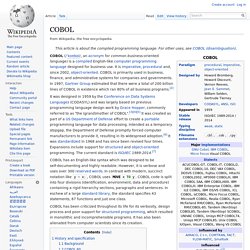
It is imperative, procedural and, since 2002, object-oriented. COBOL is primarily used in business, finance, and administrative systems for companies and governments. In 1997, Gartner Group estimated that there were a total of 200 billion lines of COBOL in existence which ran 80% of all business programs.[2] Digital scent technology.
Digital scent technology (or olfactory technology) is the engineering discipline dealing with olfactory representation.
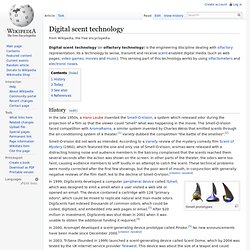
Its a technology to sense, transmit and receive scent-enabled digital media (such as web pages, video games, movies and music). This sensing part of this technology works by using olfactometers and electronic noses. History[edit] 7 Things You Need to Know About Tor. Artificial worm starts to wriggle. 20 December 2013Last updated at 09:49 ET The project to create the C. elegans nematode in code should unlock more secrets of how it lives A project to create artificial life has hit a key milestone - the simulated creature can now wriggle.
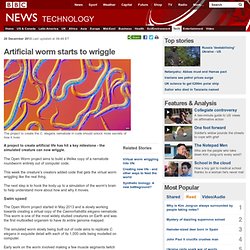
The Open Worm project aims to build a lifelike copy of a nematode roundworm entirely out of computer code. This week the creature's creators added code that gets the virtual worm wriggling like the real thing. The next step is to hook the body up to a simulation of the worm's brain to help understand more about how and why it moves. Swim speed The Open Worm project started in May 2013 and is slowly working towards creating a virtual copy of the Caenorhabditis elegans nematode. Body parts on a chip. Computer uses images to teach itself common sense. 25 November 2013Last updated at 11:39 ET Computers at Carnegie Mellon University are running a program that analyses images in a bid to learn common sense A computer program is trying to learn common sense by analysing images 24 hours a day.
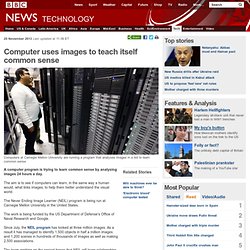
The aim is to see if computers can learn, in the same way a human would, what links images, to help them better understand the visual world. The Never Ending Image Learner (NEIL) program is being run at Carnegie Mellon University in the United States. The work is being funded by the US Department of Defense's Office of Naval Research and Google. Since July, the NEIL program has looked at three million images. The team working on the project hopes that NEIL will learn relationships between different items without being taught.
Computer programs can already identify and label objects using computer vision, which models what humans can see using hardware and software, but the researchers hope that NEIL can bring extra analysis to the data.